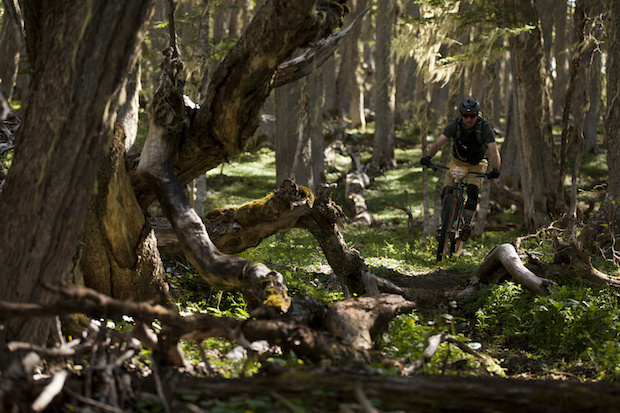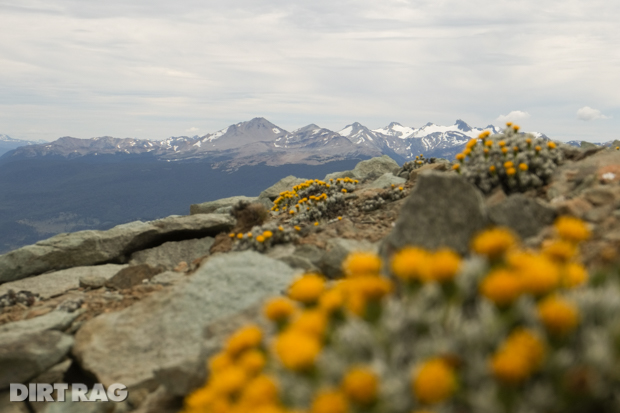First Ride – Santa Cruz Hightower 27plus/29 inch trail bike
Originally posted on February 2, 2016 at 3:11 amDisclaimer:
Junket- a free trip by a member of the press to a place where something (such as a new bike) is being promoted.
Let’s get that out of the way first. The new Santa Cruz Hightower was introduced to select members of the media on a trip to Chile for the first running of the Rally of Aysén Patagonia, a four day bike event. More about that later, just wanted to be clear that I’m well aware trips like this might be enough to cloud one’s judgment about a new bike. Fortunately, Santa Cruz isn’t making any turds.

Hightower!
The Tallboy LT quietly disappeared from the Santa Cruz line-up recently, so it came as no surprise that the new bike was a replacement. Mid-travel trail bikes with 29 inch wheels are a solid slice of the market, and Santa Cruz wasn’t about to miss out.
In a nutshell, the Hightower is a carbon-fiber-framed 29 or 27plus trail bike with 135 of rear travel, a 140 or 150 mm fork, the newest Virtual Pivot Point suspension design and thoroughly modern geometry.


What is changed from the Tallboy LT? Save for the 135 mm of rear travel, everything is new. Imagine the attitude of the Nomad, Bronson and 5010, scaled for big wheels and even bigger days.
Head and seat tube angles go from 69.4/72.6 on the TBLT to a much more aggressive 67/74.3 on the Hightower. Bottom bracket height drops about a quarter inch to 13.27 and chainstays shrink from 17.7 to 17.1 inches. Top tubes and reach grow as well. This numbers are with 29 inch wheels, the 27plus option has very minor differences. Geo chart is found here.
How about those big tires? Since the 27.5×2.8 Maxxis Ikon/Recon tires are a little smaller in diameter than the 29×2.3 Maxxis Minions, those opting for 27plus get a 150 mm fork, and a small flip-chip in the upper suspension link gets moved to the high setting.


All bikes use the excellent RockShox Pike platform, but the air-spring design of this fork means there is no way to adjust travel without swapping out the air-shaft for a longer fork. So if you want to keep geometry mostly the same while swapping wheels, you’ll either need two forks, or spend the time swapping out the air-shaft. Or, just do what most of the Santa Cruz crew does, and run a 150 mm fork all time and deal with a bit more slack and a wee bit of bottom bracket height. Considering how often I scraped a pedal, and how I never, ever wanted a steeper bike, this seems like the winning plan. It wouldn’t surprise me if this is how all the bikes come in six months or so.
Hub spacing is 148/110 (Boost) for both wheelsizes. The bottom bracket is threaded with good-old English threading and ISCG tabs. Cable routing is a mix of internal and external. Rear derailleur and dropper go through the downtube, the rear brake is routed externally on the left side.

No front derailleurs need apply here; like the Nomad, suspension linkage and chainstay length leave no room for a front shifter. If the rumors of a single ring, 12 speed, 10-50(!) cassette group from SRAM prove to be true, those with deep enough wallets might never have to worry about sacrificing the range of a double for the simplicity of a single. In the meantime, the stock 30 tooth ring and 10-42 cassette seems like plenty of gears about 90% of the time.
(Aside: Some riders on bikes with no front derailleur compatibility are running a standard narrow-wide ring, a granny ring and no front derailleur. Shifting is via your hand, so it isn’t really enduro-approved, but an interesting idea for those rare times a single ring drivetrain isn’t enough range.)


Do I hear the question about an aluminum frame? I heard that question in my own head, and the answer is: nope. Carbon in CC and C versions only, with the frame only in CC, at $2,899 with Monarch LT. A shame, and it certainly keeps these out of the garage of many riders without a solid chunk of disposable income.
All bikes come with a 150 mm RockShox Reverb Stealth, either Maxxis Rekon/Ikon 27.5×2.8 EXO 3C TR/ or Maxxis Minion 29×2.3 DHR2 TR tires, an 800 mm Santa Cruz carbon handlebar, and Santa Cruz Palmdale grips. Get your ENVE carbon upgrade on for $2,000, with M Series 60 Forty HV rims and I9 hubs, 29 inch only.
Colors are Sriracha Red or Matte Carbon & Mint
- S AM 27plus or 29
- Carbon C frame
- Rock Shox Monarch RT
- Rock Shox Pike RC
- SRAM GX 1×11 RD
- Shimano SLX M675 brakes
- SRAM MTH hubs
- Easton AR 40/29.67/29.72 lbs.
Hightower CC – $6,499
- XO1 AM 27plus or 29
- Carbon CC frame
- Rock Shox Monarch RT3
- Rock Shox Pike RCT3
- SRAM X01 Carbon 11sp RD
- SRAM Guide RSC brakes
- DT 350 hubs
- Easton ARC 40 / ARC 27 28H
- 27.96/ 28.05 lbs.
Hightower CC – $7,799
- XX1 AM 27plus or 29
- Carbon CC frame
- Rock Shox Monarch RT3
- Rock Shox Pike RCT3 150
- SRAM XX1
- SRAM Guide Ultimate brakes
- Industry Nine 15/110mm 28H
- Industry Nine 148×12 28h Rear hub XD
- Easton ARC 40/ARC 27 28H
- 27.18/27.26 lbs.
Hightower CC VPP Frameset with RockShox Monarch RTS – $2,899
- Weight: 2,678g / 5.88 lbs.

The Ride
The trip to Chile wasn’t solely about the new bike. Santa Cruz is throwing its support behind a new event in southern Chile, a not-quite-a-race called the Rally of Aysén Patagonia. A bunch of us media types, some of the Juliana team, various photographers and Cedric Gracia got a four day tour around Coyhaique, which is about 1,300 miles south of Santiago.

We covered all kinds of terrain. Shale scree fields. Dusty doubletrack. Hot gravel roads. Dozens of barbed wire fence crossings. Freshly cut loam. Miles of cow paths. Hike-a-bikes. Steep, loose singletrack descents. In fact, this may be one of widest-ranging, and highest mileage of any press event I’ve been to.

The Hightower took it all in stride. It has the downhill chops to be ridden quite hard, but pedals well enough that I could have happily ridden it without ever messing with the platform lever on the Monarch rear shock. I never really felt like I got in the grove down there, so I won’t even pretend that I even close to the edge of performance on this one. I can say it most have been stiff enough, because I never thought about it.
Climbing was great, although on the real steep stuff, those short chainstays take more work to keep the back wheel biting and the front wheel down. There is room for a bottle inside the front triangle on all three sizes.

We rode miles of new trail, with no idea what was around the next corner, and I came way impressed with how well this bike handled that type of stuff. Enough stability to ride out bad line choices, but enough fun-factor to be able to pull-up hard and hop over those hidden logs. It even did a fine job meandering around on the cow-path sections.
The parts kit is a no brainer these days, all these SRAM bits work very well. I only rode the 29er version, with ENVE wheels and XO1 kit.
I flew home with a 27plus version of this bike, and few rides on it make me think I’d want both wheelset. The 29er for most of the summer, and some aggressive tires for the 27plus wheelset for the sloppy season and snow.
Stay tuned for a full review, and more info on the Rally of Aysén Patagonia.









